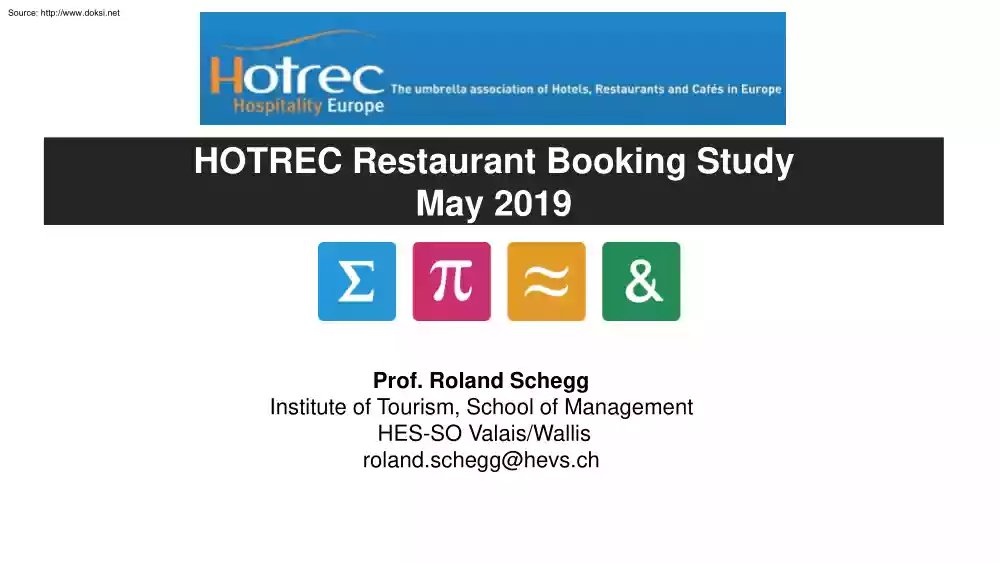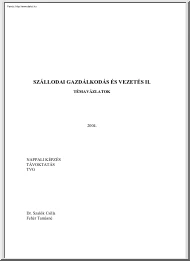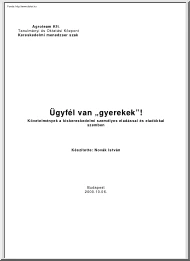Datasheet
Year, pagecount:2019, 15 page(s)
Language:English
Downloads:2
Uploaded:February 06, 2020
Size:1 MB
Institution:
-
Comments:
Attachment:-
Download in PDF:Please log in!
Comments
No comments yet. You can be the first!Content extract
Source: http://www.doksinet HOTREC Restaurant Booking Study May 2019 Prof. Roland Schegg Institute of Tourism, School of Management HES-SO Valais/Wallis roland.schegg@hevsch Source: http://www.doksinet Summary: Context • • In order to map and assess the current market situation concerning restaurant bookings and deliveries in Europe, HOTREC, the umbrella association of Hotels, Restaurants and Cafés in Europe, has decided to conduct a study in 2018. As these markets are more and more on the growth, the industry associations would like to have an updated picture about how restaurant reservations are being made by the guests, who are the key players, and what are the main trends. Secondary desk research, an online survey among 790 European restaurants and an inspection of 1200 restaurants websites in France and Germany allowed to draw an actual picture on the importance of booking and delivery services in the European restaurants sector. HES-SO Valais-Wallis Page 2 Source:
http://www.doksinet Summary: Market Trends • “The restaurant industry faces a variety of challenges to keep pace with the rapid changes driven by consumer trends and demographic change such as growing preferences for healthier foods, concerns about environmental sustainability, increasing competition from grocery stores, increased consumer expectations as well as rapidly evolving technologies that are reinventing the traditional food experience and forcing a change in the way the industry works” (KPMG 2016). • Today consumers are constantly connected and have high expectations of quality, sustainability and convenience (KPMG 2016): ➢ Their way of thinking values "experience" and " convenience". ➢ These empowered consumers shop anytime, anywhere, which means that restaurants must bring food to consumers where and when they want it to remain relevant. ➢ Restaurants and food delivery companies are responding with improved business models to create
tailored, technology-driven experiences. HES-SO Valais-Wallis Page 3 Source: KPMG (2016): An appetite for change. Key trends driving innovation in the restaurant industry. Source: http://www.doksinet Summary: Food Delivery Market Trends • • • Online food delivery platforms expand choice and convenience, allowing customers to order from a variety of restaurants with a single click on their mobile phone. The business of delivering restaurant meals to the home is changing rapidly as various new online portals develop in Europe and internationally. These platforms are attracting significant investment and high valuations (estimated market caps of players between 2 and 20 billion Euros). After the rise and demise of several local startups, many takeovers and international expansions, it becomes clearer that the food delivery market in Europe will be dominated by the following players: Uber Eats, Deliveroo, Delivery Hero, TakeAway and JustEat. Yet overall, the competitive
landscape is still complex and no dominant player has emerged. The number of online food delivery users in Europe is expected to be around 200 million in 2023 and revenues of the food delivery sector are expected to show an annual growth rate of roughly 10% in the following years and reach probably nearly 20 billion Euro in 2023. HES-SO Valais-Wallis Page 4 Source: http://www.doksinet Summary: Importance of Food Delivery • Less than 10% of restaurants in our restaurant survey worked with food delivery services for a median turnover of 2% (compared to overall revenue). Main motivations for restaurants to work with food delivery are to get additional revenues, future seated customers and market visibility (marketing tool). HES-SO Valais-Wallis Page 5 Source: http://www.doksinet Summary: Restaurant Booking • • • Our survey indicates that nearly half of guest (43%) book a table in advance in European restaurants. Nine out of ten of theses advanced bookings are still
direct (main channels phone 64% and e-mail 12%) whereas third-party platforms generate roughly 6% of advanced bookings. An analysis of 1200 restaurants in Germany and France shows that nearly 20% of restaurants offer third-party booking options on their own website and only 11% have an own online reservation system. The individual third-party booking platforms are generally used by less than 10% of the analyzed restaurants. Major online restaurant reservation platforms in Europe are in the hand of established global players. Five main players can be identified in Europe connecting diners with 20’000 to 51’000 restaurants: OpenTable (Booking Holding), ResDiary (Accor Hotels), lafourchette/thefork (TripAdvsior), Quandoo (Recruit) and Bookatable (Michelin). HES-SO Valais-Wallis Page 6 Source: http://www.doksinet Summary: Conclusions • Restaurant booking portals and online delivery services are still in an early stage in Europe. • But given changes in consumer behavior
(millennials, generation Z, etc.), technology evolutions (penetration of mobile technology, development of automated delivery), the slow digital transformation of the restaurant sector, the growth potential for these new players seems to be significant. • Yet, these new services may also represent growth opportunities for the enterprises in the hospitality sector if cost issues (commissions) and strategic aspects (e.g dependency on international/global players, evolution of business models) are managed properly. HES-SO Valais-Wallis Page 7 Source: http://www.doksinet An Overview on Trends in the Food and Restaurant Sector based on Industry Reports and Own Research HES-SO Valais-Wallis Page 8 Source: http://www.doksinet 7 Restaurant industry trends Preferences for healthier food options Increase in food service options “Consumers prefer to eat at home and, if dining out, are inclined to consume healthier and less processed foods.” “Restaurants have been losing market
share to supermarkets, which have started stocking wide ranges of ready-to-eat meals; further, an increasing number of them have added eat-in areas. Modification of menu items driven by regulatory norms “With nutrition labeling requirements being enforced by the Affordable Care Act, restaurant operators are obligated to make changes to menus to show the calorie counts of their products.” Technological advancements “Restaurant chains are adopting new technologies for ordering, payment, and loyalty programs to offer convenient and intuitive applications for customers.” Environment sustainability Focus on Generation Z “Restaurants have been focusing on reducing food waste to manage rising costs and to “go green”.” “Restaurants are currently trying to appeal to millennials and are competing for the attention of this social media savvy generation. They also need to be mindful of Generation Z as younger teens are beginning to make their own decisions about where to
eat and what to eat. Inclination towards global cuisines “Increase in preferences for global/ethnic cuisines is prompting restaurants to diversify their businesses.” HES-SO Valais-Wallis Page 9 Impact on Restaurant Booking and Food Delivery Adapted from KPMG (2016): An appetite for change. Key trends driving innovation in the restaurant industry. https://assetskpmg/content/dam/kpmg/pdf/2016/07/kr-gtl-an-appetite-for-changepdf Source: http://www.doksinet Customer Behavior in Food Delivery Market • Customers attracted to the new online food delivery platforms have different needs and expectations than traditional pizzeria customers. A McKinsey study in 2016 uncovered the following important traits: • “Platforms are sticky. New-delivery platforms, which personalize the ordering experience by storing relevant customer data, are sticky. Once customers sign up, 80 percent never or rarely leave for another platform, creating a strong winner-take-all dynamic, in which the
reward goes to the player who can sign up the most customers in the shortest amount of time. • Time is critical. Speed of delivery is the biggest variable in customer satisfaction, with an average 60 percent of consumers across markets citing it as a key factor. The optimal wait time is no more than 60 minutes. • Meals are for home. Most orders82 percentwere placed from home, while only 16 percent were placed from the workplace. • Orders spike on weekends. The highest-volume days for the online platforms were Friday, Saturday, and Sunday, when 74 percent of orders were placed.” HES-SO Valais-Wallis Source: McKinsey (2016): The changing market for food delivery. Page 10 https://www.mckinseycom/industries/high-tech/our-insights/the-changing-market-for-food-delivery Source: http://www.doksinet Food Delivery Market Sizes: UK Dominant Market in Europe UK is by far the largest market, thanks to high order frequency and online penetration in food delivery People ordering food
(in million) 0 20 40 Market Size (Gross Markt Value in Billion Euro) 60 Germany 56 UK 46 Russia 43 France 33 Italy 30 Sapin 23 Poland 19 Netherlands 10 0 2 4 6 UK 8 7.2 Germany 4.5 France 4.3 Online Penetration (in %) 0.0% 20.0% 40.0% UK 60.0% 49.1% Netherlands 32.7% Denmark 27.4% Online Market (Gross Markt Value in Billion Euro) 0 1 UK Germany 0.8 France 0.6 3 Poland Italy 2.5 Belgium 19.1% Spain Austria 19.0% Italy 0.2 Netherlands 1.5 Poland 1.2 Russia 1.1 Red: online Blue: offline Netherlands 0.5 0.4 Finland 17.3% Russia 0.2 Switzerland 17.0% Belgium 0.2 Belgium 6 Austria 0.8 Sweden 16.2% Austria 0.2 Austria 6 Belgium 0.8 Germany 15.2% Denmark 0.2 Sweden 5 Sweden 0.8 Russia 13.5% Sweden 0.1 Switzerland 4 Switzerland 0.6 France 13.4% Poland 0.1 Denmark 3 Denmark 0.5 Finland 3 Norway 0.4 Norway 3 Finland 0.4 Total Market (offline & online) growing 5% per year
HES-SO Valais-Wallis Page 11 Vast majority of offline is take-out collection Spain 11.9% Switzerland 0.1 Norway 10.8% Finland 0.1 Italy 5.3% Norwayy 3 4 3.5 Spain 23.4% 2 0 Source: Dealroom and Priori Data (2017): Food Delivery Tech – Battle for the Europen Consumer Source: http://www.doksinet European Food Delivery Landscape (pro forma Takeaway.com deal) #1 in UK, Italy, Spain, France, Portugal #1 in Germany and Sweden #2 in Poland Present across Eastern Europe post FoodPanda acquisition in December 2016 Present across Eastern Europe (and Asia and LatAm) Focus on emerging markets #1 in Netherlands and Poland Takeover of German operations of Delivery Hero (to be finalised in 2019) Leader in premium segment Strong #2 in France Leader in Barcelona and Madrid with «order anything» concept HES-SO Valais-Wallis Page 12 Adapted from Dealroom.com (2018) Food Tech & Delivery Marketplaces in Europe AECOC Madrid, 31 May 2018 &
https://blog.dealroomco/after-delivery-hero-takeaway-com-deal-whats-next-in-food-delivery- Source: http://www.doksinet European Food & Restaurant Market: 1000 Billion Euro Market with Low Online Penetration 2000 1000 900 800 700 600 500 500 500 400 2% -> online penetration 300 300 200 200 100 100 2% 10% <1% 10% 0 Healthcare Services Groceries Restaurant & bars Fashion HES-SO Valais-Wallis Page 13 90 40% 3% Home & Living Total 100 Wellness Flights 40% Hotels 30 6% Taxi Online Adapted from: Dealroom.com (2018) Food Tech & Delivery Marketplaces in Europe AECOC Madrid, 31 May 2018 30 20% Delivery Source: http://www.doksinet Market Power of Platforms and Commissions Higher when Supply is Abundant Commission Hotels 15-30% Taxis Food Delivery 10-15% 5-10% Fashion Table Bookings Super Markets 0-5% Flights Market Power HES-SO Valais-Wallis Page 14 Adpated from Dealroom.com (2018) Food Tech & Delivery Marketplaces in
Europe AECOC Madrid, 31 May 2018 Source: http://www.doksinet Restaurant Booking Market Player Comparison 51’000 restaurants / 20 countries / 1’452 million diners/year Market Cap: 83’000 Mio $ 59’300 restaurants / 62 countries / 178 million diners/year 56’000 restaurants / 11 countries / ?? million diners/year Market Cap: 11’000 Mio $ Market Cap: 7’000 Mio $ 15’000 restaurants / 16 countries / 100 million diners/year Market Cap: 48’000 Mio $ 20’000 restaurants / 40 countries / 39 million diners/year Market Cap: 23’000 Mio $ HES-SO Valais-Wallis Page 15
http://www.doksinet Summary: Market Trends • “The restaurant industry faces a variety of challenges to keep pace with the rapid changes driven by consumer trends and demographic change such as growing preferences for healthier foods, concerns about environmental sustainability, increasing competition from grocery stores, increased consumer expectations as well as rapidly evolving technologies that are reinventing the traditional food experience and forcing a change in the way the industry works” (KPMG 2016). • Today consumers are constantly connected and have high expectations of quality, sustainability and convenience (KPMG 2016): ➢ Their way of thinking values "experience" and " convenience". ➢ These empowered consumers shop anytime, anywhere, which means that restaurants must bring food to consumers where and when they want it to remain relevant. ➢ Restaurants and food delivery companies are responding with improved business models to create
tailored, technology-driven experiences. HES-SO Valais-Wallis Page 3 Source: KPMG (2016): An appetite for change. Key trends driving innovation in the restaurant industry. Source: http://www.doksinet Summary: Food Delivery Market Trends • • • Online food delivery platforms expand choice and convenience, allowing customers to order from a variety of restaurants with a single click on their mobile phone. The business of delivering restaurant meals to the home is changing rapidly as various new online portals develop in Europe and internationally. These platforms are attracting significant investment and high valuations (estimated market caps of players between 2 and 20 billion Euros). After the rise and demise of several local startups, many takeovers and international expansions, it becomes clearer that the food delivery market in Europe will be dominated by the following players: Uber Eats, Deliveroo, Delivery Hero, TakeAway and JustEat. Yet overall, the competitive
landscape is still complex and no dominant player has emerged. The number of online food delivery users in Europe is expected to be around 200 million in 2023 and revenues of the food delivery sector are expected to show an annual growth rate of roughly 10% in the following years and reach probably nearly 20 billion Euro in 2023. HES-SO Valais-Wallis Page 4 Source: http://www.doksinet Summary: Importance of Food Delivery • Less than 10% of restaurants in our restaurant survey worked with food delivery services for a median turnover of 2% (compared to overall revenue). Main motivations for restaurants to work with food delivery are to get additional revenues, future seated customers and market visibility (marketing tool). HES-SO Valais-Wallis Page 5 Source: http://www.doksinet Summary: Restaurant Booking • • • Our survey indicates that nearly half of guest (43%) book a table in advance in European restaurants. Nine out of ten of theses advanced bookings are still
direct (main channels phone 64% and e-mail 12%) whereas third-party platforms generate roughly 6% of advanced bookings. An analysis of 1200 restaurants in Germany and France shows that nearly 20% of restaurants offer third-party booking options on their own website and only 11% have an own online reservation system. The individual third-party booking platforms are generally used by less than 10% of the analyzed restaurants. Major online restaurant reservation platforms in Europe are in the hand of established global players. Five main players can be identified in Europe connecting diners with 20’000 to 51’000 restaurants: OpenTable (Booking Holding), ResDiary (Accor Hotels), lafourchette/thefork (TripAdvsior), Quandoo (Recruit) and Bookatable (Michelin). HES-SO Valais-Wallis Page 6 Source: http://www.doksinet Summary: Conclusions • Restaurant booking portals and online delivery services are still in an early stage in Europe. • But given changes in consumer behavior
(millennials, generation Z, etc.), technology evolutions (penetration of mobile technology, development of automated delivery), the slow digital transformation of the restaurant sector, the growth potential for these new players seems to be significant. • Yet, these new services may also represent growth opportunities for the enterprises in the hospitality sector if cost issues (commissions) and strategic aspects (e.g dependency on international/global players, evolution of business models) are managed properly. HES-SO Valais-Wallis Page 7 Source: http://www.doksinet An Overview on Trends in the Food and Restaurant Sector based on Industry Reports and Own Research HES-SO Valais-Wallis Page 8 Source: http://www.doksinet 7 Restaurant industry trends Preferences for healthier food options Increase in food service options “Consumers prefer to eat at home and, if dining out, are inclined to consume healthier and less processed foods.” “Restaurants have been losing market
share to supermarkets, which have started stocking wide ranges of ready-to-eat meals; further, an increasing number of them have added eat-in areas. Modification of menu items driven by regulatory norms “With nutrition labeling requirements being enforced by the Affordable Care Act, restaurant operators are obligated to make changes to menus to show the calorie counts of their products.” Technological advancements “Restaurant chains are adopting new technologies for ordering, payment, and loyalty programs to offer convenient and intuitive applications for customers.” Environment sustainability Focus on Generation Z “Restaurants have been focusing on reducing food waste to manage rising costs and to “go green”.” “Restaurants are currently trying to appeal to millennials and are competing for the attention of this social media savvy generation. They also need to be mindful of Generation Z as younger teens are beginning to make their own decisions about where to
eat and what to eat. Inclination towards global cuisines “Increase in preferences for global/ethnic cuisines is prompting restaurants to diversify their businesses.” HES-SO Valais-Wallis Page 9 Impact on Restaurant Booking and Food Delivery Adapted from KPMG (2016): An appetite for change. Key trends driving innovation in the restaurant industry. https://assetskpmg/content/dam/kpmg/pdf/2016/07/kr-gtl-an-appetite-for-changepdf Source: http://www.doksinet Customer Behavior in Food Delivery Market • Customers attracted to the new online food delivery platforms have different needs and expectations than traditional pizzeria customers. A McKinsey study in 2016 uncovered the following important traits: • “Platforms are sticky. New-delivery platforms, which personalize the ordering experience by storing relevant customer data, are sticky. Once customers sign up, 80 percent never or rarely leave for another platform, creating a strong winner-take-all dynamic, in which the
reward goes to the player who can sign up the most customers in the shortest amount of time. • Time is critical. Speed of delivery is the biggest variable in customer satisfaction, with an average 60 percent of consumers across markets citing it as a key factor. The optimal wait time is no more than 60 minutes. • Meals are for home. Most orders82 percentwere placed from home, while only 16 percent were placed from the workplace. • Orders spike on weekends. The highest-volume days for the online platforms were Friday, Saturday, and Sunday, when 74 percent of orders were placed.” HES-SO Valais-Wallis Source: McKinsey (2016): The changing market for food delivery. Page 10 https://www.mckinseycom/industries/high-tech/our-insights/the-changing-market-for-food-delivery Source: http://www.doksinet Food Delivery Market Sizes: UK Dominant Market in Europe UK is by far the largest market, thanks to high order frequency and online penetration in food delivery People ordering food
(in million) 0 20 40 Market Size (Gross Markt Value in Billion Euro) 60 Germany 56 UK 46 Russia 43 France 33 Italy 30 Sapin 23 Poland 19 Netherlands 10 0 2 4 6 UK 8 7.2 Germany 4.5 France 4.3 Online Penetration (in %) 0.0% 20.0% 40.0% UK 60.0% 49.1% Netherlands 32.7% Denmark 27.4% Online Market (Gross Markt Value in Billion Euro) 0 1 UK Germany 0.8 France 0.6 3 Poland Italy 2.5 Belgium 19.1% Spain Austria 19.0% Italy 0.2 Netherlands 1.5 Poland 1.2 Russia 1.1 Red: online Blue: offline Netherlands 0.5 0.4 Finland 17.3% Russia 0.2 Switzerland 17.0% Belgium 0.2 Belgium 6 Austria 0.8 Sweden 16.2% Austria 0.2 Austria 6 Belgium 0.8 Germany 15.2% Denmark 0.2 Sweden 5 Sweden 0.8 Russia 13.5% Sweden 0.1 Switzerland 4 Switzerland 0.6 France 13.4% Poland 0.1 Denmark 3 Denmark 0.5 Finland 3 Norway 0.4 Norway 3 Finland 0.4 Total Market (offline & online) growing 5% per year
HES-SO Valais-Wallis Page 11 Vast majority of offline is take-out collection Spain 11.9% Switzerland 0.1 Norway 10.8% Finland 0.1 Italy 5.3% Norwayy 3 4 3.5 Spain 23.4% 2 0 Source: Dealroom and Priori Data (2017): Food Delivery Tech – Battle for the Europen Consumer Source: http://www.doksinet European Food Delivery Landscape (pro forma Takeaway.com deal) #1 in UK, Italy, Spain, France, Portugal #1 in Germany and Sweden #2 in Poland Present across Eastern Europe post FoodPanda acquisition in December 2016 Present across Eastern Europe (and Asia and LatAm) Focus on emerging markets #1 in Netherlands and Poland Takeover of German operations of Delivery Hero (to be finalised in 2019) Leader in premium segment Strong #2 in France Leader in Barcelona and Madrid with «order anything» concept HES-SO Valais-Wallis Page 12 Adapted from Dealroom.com (2018) Food Tech & Delivery Marketplaces in Europe AECOC Madrid, 31 May 2018 &
https://blog.dealroomco/after-delivery-hero-takeaway-com-deal-whats-next-in-food-delivery- Source: http://www.doksinet European Food & Restaurant Market: 1000 Billion Euro Market with Low Online Penetration 2000 1000 900 800 700 600 500 500 500 400 2% -> online penetration 300 300 200 200 100 100 2% 10% <1% 10% 0 Healthcare Services Groceries Restaurant & bars Fashion HES-SO Valais-Wallis Page 13 90 40% 3% Home & Living Total 100 Wellness Flights 40% Hotels 30 6% Taxi Online Adapted from: Dealroom.com (2018) Food Tech & Delivery Marketplaces in Europe AECOC Madrid, 31 May 2018 30 20% Delivery Source: http://www.doksinet Market Power of Platforms and Commissions Higher when Supply is Abundant Commission Hotels 15-30% Taxis Food Delivery 10-15% 5-10% Fashion Table Bookings Super Markets 0-5% Flights Market Power HES-SO Valais-Wallis Page 14 Adpated from Dealroom.com (2018) Food Tech & Delivery Marketplaces in
Europe AECOC Madrid, 31 May 2018 Source: http://www.doksinet Restaurant Booking Market Player Comparison 51’000 restaurants / 20 countries / 1’452 million diners/year Market Cap: 83’000 Mio $ 59’300 restaurants / 62 countries / 178 million diners/year 56’000 restaurants / 11 countries / ?? million diners/year Market Cap: 11’000 Mio $ Market Cap: 7’000 Mio $ 15’000 restaurants / 16 countries / 100 million diners/year Market Cap: 48’000 Mio $ 20’000 restaurants / 40 countries / 39 million diners/year Market Cap: 23’000 Mio $ HES-SO Valais-Wallis Page 15





